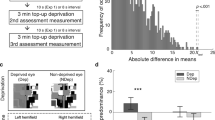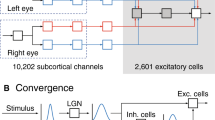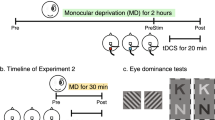Abstract
Monocular lid suture during the sensitive period early in the life of a kitten disrupts normal development of inputs from the two eyes to the visual cortex, causing a decrease in the fraction of cortical cells responding to the deprived eye1. Such an ocular dominance shift has been assumed to depend on patterned visual experience, because no change in cortical physiology is produced by inequalities between the two eyes in retinal illumination2 or temporally modulated diffuse light stimulation3,4. A higher-level process, involving gating signals from areas outside striate cortex, has been proposed to ensure that sustained changes in synaptic efficacy occur only in response to behaviourally significant visual inputs5. To test whether such a process is necessary for ocular dominance plasticity, we treated 4-week-old kittens with visual deprivation and monocular tetrodotoxin (TTX) injections to create an imbalance in the electrical activities of the two retinas in the absence of patterned vision. After 1 week of treatment we determined the ocular dominance distribution of single units in primary visual cortex. In all kittens studied, a significant ocular dominance shift was found. In addition to this physiological change, there was an anatomical change in the lateral geniculate nucleus, where cells were larger in laminae receiving input from the more active eye. Our results indicate that patterned vision is not necessary for visual cortical plasticity, and that an imbalance in spontaneous retinal activity alone can produce a significant ocular dominance shift.
This is a preview of subscription content, access via your institution
Access options
Subscribe to this journal
Receive 51 print issues and online access
$199.00 per year
only $3.90 per issue
Buy this article
- Purchase on Springer Link
- Instant access to full article PDF
Prices may be subject to local taxes which are calculated during checkout
Similar content being viewed by others
References
Wiesel, T. N. & Hubel, D. H. J. Neurophysiol. 26, 1003–1017 (1963).
Blakemore, C. J. Physiol., Lond. 261, 423–444 (1976).
Singer, W., Rauschecker, J. & Werth, R. Brain Res. 134, 568–572 (1977).
Wilson, J. R., Webb, S. V. & Sherman, S. M. Brain Res. 136, 277–287 (1977).
Singer, W. in The Neurosciences Fourth Study Program (eds Schmitt, F. O. & Worden, F. G.) 1093–1110 (MIT, Cambridge, 1979).
Stryker, M. P. & Harris, W. J. Neurosci. 6, 2117–2133 (1986).
Schopmann, A. & Stryker, M. P. Nature 293, 574–576 (1981).
Hubel, D. H. & Wiesel, T. N. J. Physiol., Lond. 160, 106–154 (1962).
Movshon, J. A. & Dursteler, M. R. J. Neurophysiol. 40, 1255–1265 (1977).
Kuppermann, B. D. & Kasamatsu, T. Nature 306, 465–468 (1983).
Movshon, J. A. J. Physiol., Lond. 261, 125–174 (1976).
Reiter, H. O., Waitzman, D. M. & Stryker, M. P. Soc. Neurosci. Abstr. 11, 463 (1985).
Eysel, U. T. & Wolfherd, E. J. comp. Neurol. 229, 301–309 (1983).
Harris, W. A. & Stryker, M. P. Soc. Neurosci. Abstr. 3, 1785 (1977).
Hubel, D. H. & Wiesel, T. N. J. Physiol., Lond. 206, 419–436 (1970).
Olson, C. R. & Freeman, R. D. J. Neurophysiol. 38, 26–32 (1975).
Stryker, M. P. Soc. Neurosci. Abstr. 7, 842 (1981).
Stryker, M. P. in Developmental Neurophysiology (eds Kellaway, P. & Purpura, D.) (Johns Hopkins University, in the press).
LeVay, S. & Stryker, M. P. in Aspects of Developmental Neurobiology (ed. Ferrendelli, J. A.) 83–96 (Soc. Neurosci, 1979).
LeVay, S., Wiesel, T. N. & Hubel, D. H. J. comp. Neurol. 191, 1–51 (1980).
Rakic, P. Nature 261, 467–471 (1976).
Des Rosiers, M. H. et al. Science 200, 447–449 (1978).
Shatz, C. & Kirkwood, P. J. Neurosci. 4, 1378–1397 (1984).
Dubin, M. W., Stark, L. A. & Archer, S. M. J. Neurosci. 6, 1021–1036 (1986).
Sur, M., Garraghty, P. E. & Stryker, M. P. Soc. Neurosci. Abstr. 11, 805 (1985).
Sanderson, K. J. J. comp. Neurol. 143, 101–118 (1971).
Author information
Authors and Affiliations
Rights and permissions
About this article
Cite this article
Chapman, B., Jacobson, M., Reiter, H. et al. Ocular dominance shift in kitten visual cortex caused by imbalance in retinal electrical activity. Nature 324, 154–156 (1986). https://doi.org/10.1038/324154a0
Received:
Accepted:
Issue Date:
DOI: https://doi.org/10.1038/324154a0
This article is cited by
-
A model for the development of binocular congruence in primary visual cortex
Scientific Reports (2022)
-
Generalized neural field theory of cortical plasticity illustrated by an application to the linear phase of ocular dominance column formation in primary visual cortex
Biological Cybernetics (2022)
-
Correction to: Modeling Axonal Plasticity in Artificial Neural Networks
Neural Processing Letters (2021)
-
Modeling Axonal Plasticity in Artificial Neural Networks
Neural Processing Letters (2021)
-
Sensory input is required for callosal axon targeting in the somatosensory cortex
Molecular Brain (2013)
Comments
By submitting a comment you agree to abide by our Terms and Community Guidelines. If you find something abusive or that does not comply with our terms or guidelines please flag it as inappropriate.



